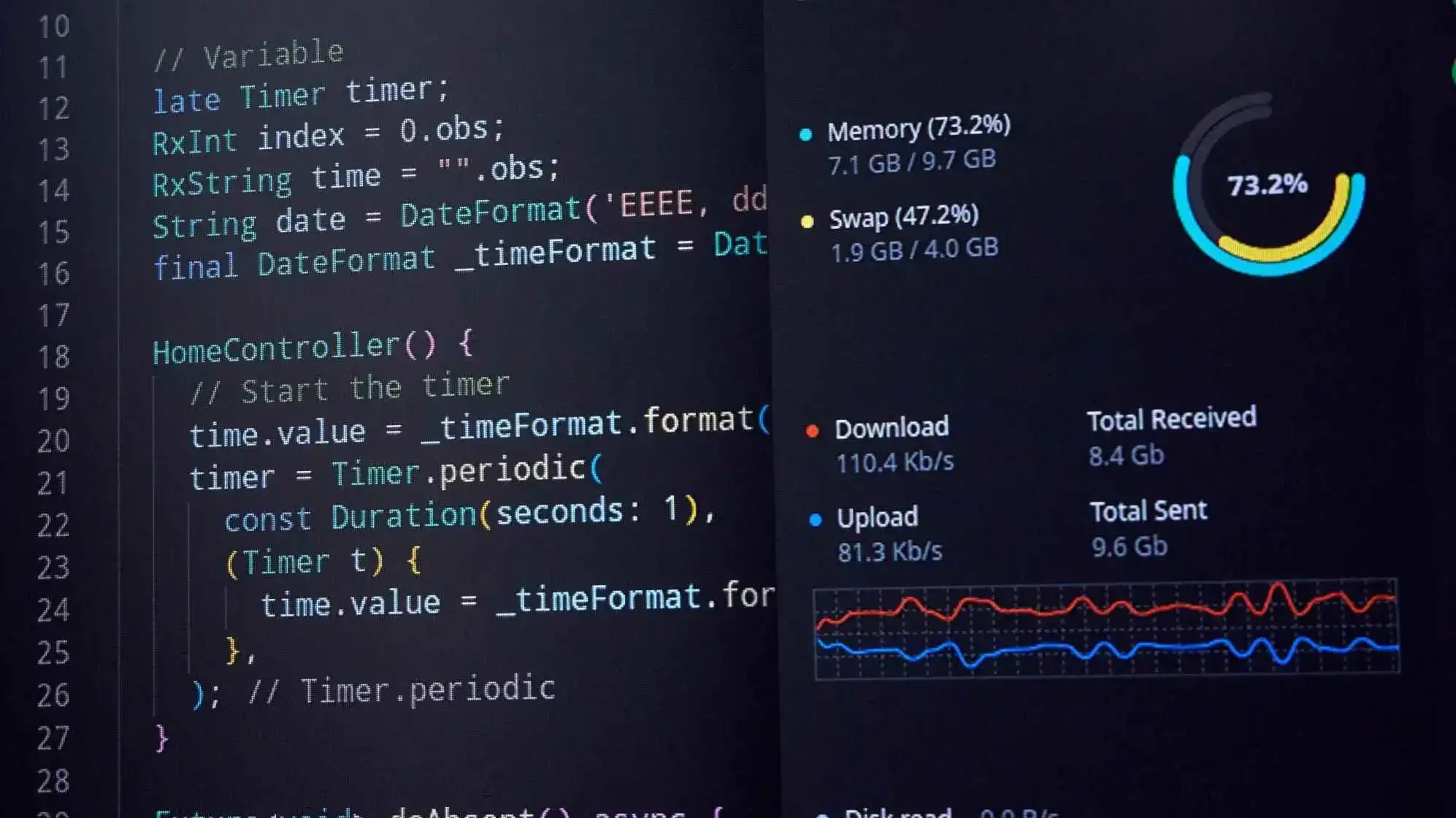Developing applications for different operating systems and devices requires several tools like; IDE, frameworks, programming languages, version control systems, package managers, emulators, and simulators for testing, etc.
Building mobile apps across different platforms like IOS and Android requires platform-specific languages. IOS developers use Objective-C or Swift with XCode while, Android developers use Java or Kotlin with Android Studio, and these platforms differ in their development environment, UI components, and so on.
Frameworks were developed to address the limitations of developing applications across different platforms.
A common development tool or framework used to build multi-platform applications is called ‘Flutter’. In this article, we’ll learn more about the Flutter framework or toolkit and why it’s a good choice for building applications across operating systems and devices.
But first,
What are cross-platform applications?
Cross-platform or multi-platform applications are a type of applications that work on different operating systems or devices such as Windows, MacOS, Android, or IOS. These applications have the same codebase, meaning developers only have to write code once which can be deployed across multiple platforms.
The importance of cross-platform applications includes;
- Faster development time
- Faster time-to-market
- Code reusability
- Uniformity and Consistency
- Cost Saving
Now that we understand what cross-platform application means, let's explore what the Flutter framework involves.
What is Flutter Framework?
Flutter is an open-source software development kit (tools and services to help create applications easily) developed by Google. It is used for building native compiled and cross-platform applications from a single code base, for example, mobile, web, desktop, and embedded devices.
Flutter formerly called Sky Engine until 2016, was first introduced to the world in 2015 at the Dart developer summit, and was publicly released in May 2017. The Sky or Flutter team wanted to solve four issues developers were having;
- Creation of a visually appealing application
- Ensuring consistent and reliable performance of applications across different environments.
- Developer experience
- Creating open and flexible applications
Previously, building an Android / IOS app involved creating two codebases, flutter was introduced to build cross-platform applications reducing development time, and cost, amongst other advantages. Now, when code is written using Flutter it can be compiled into different machine codes depending on the platform the app is running on.
Significance of flutter framework.
- The use of one programming language to create two different platform applications (Android /IOS)
- The development process is made faster and easier
- Developers do not require Xcode for IOS and Android Studio for Android development.
- The hot reload feature allows developers to see results immediately after changes are made to their code.
- Flutter uses JIT (just in time) and AOT (ahead of time) compilation which optimizes performance.
Applications that can be built using Flutter include, but are not limited to;
- E-commerce apps
- Games apps
- Social Media apps
- Productivity apps
- Machine learning apps
Features of Flutter
Single codebase: Developers use a single code base and can deploy applications on Android and IOS at the same time. This reduces the cost of building applications on different platforms (desktop and web apps) and development time.
Hot reload function: This is one of the first features of flutter. It allows developers to see the changes and updates the codebase in real time without rebuilding the entire app.
Widgets: A common term says “Almost everything on Flutter is a widget”. Flutter has a library or collection of visual, structural, platform, and interactive widgets for creating visually appealing apps faster.
These widgets are used to create the structure and layout of an application's UI elements e.g. Containers, images, text fields, etc.
Open Source and Community Support: Flutter is open source which means it is free to use and is improved by a community of developers globally. Developers can share new features or improve features, solve issues, etc. There are resources and solutions available for reference. This helps to build collaboration amongst developers.
Dart Programming Language: Dart programming language is used to develop web and mobile applications, and Flutter depends on Dart programming because of its features which include; fast run time. Also, it’s designed to handle cross-platform development.
Flutter rendering engine (Impeller): Flutters introduced a new renderer (a renderer translates UI code into pixels seen on the screen) called Impeller. Before the introduction of the impeller, flutter used a renderer called SKIA.
Skia wasn’t optimized for Flutter needs, its new renderer impeller was built for the needs of Flutter applications. According to the Flutter team, the goal was to eliminate poor quality or interruptions inside an application for a better user experience.
IDE and BAAS (Backend-as-a-service) Support: Flutter supports various integrated development environments (IDEs) that are used to develop apps—E.g. Visual Studio Code, Android Studio, Emacs, etc.
Also, backend-as-a-service platforms like Google Firebase, offer support for Android, web, and IOS apps. Using the FlutterFire CLI, you can call a single command on your IDE to integrate Firebase into your Flutter application.
Integrating Firebase into a Flutter app allows developers access to backend services and tools like real-time database, cloud storage, etc. for better experience and efficiency within an application.
Flutter Architectural Layers
Flutter architectural layers include;
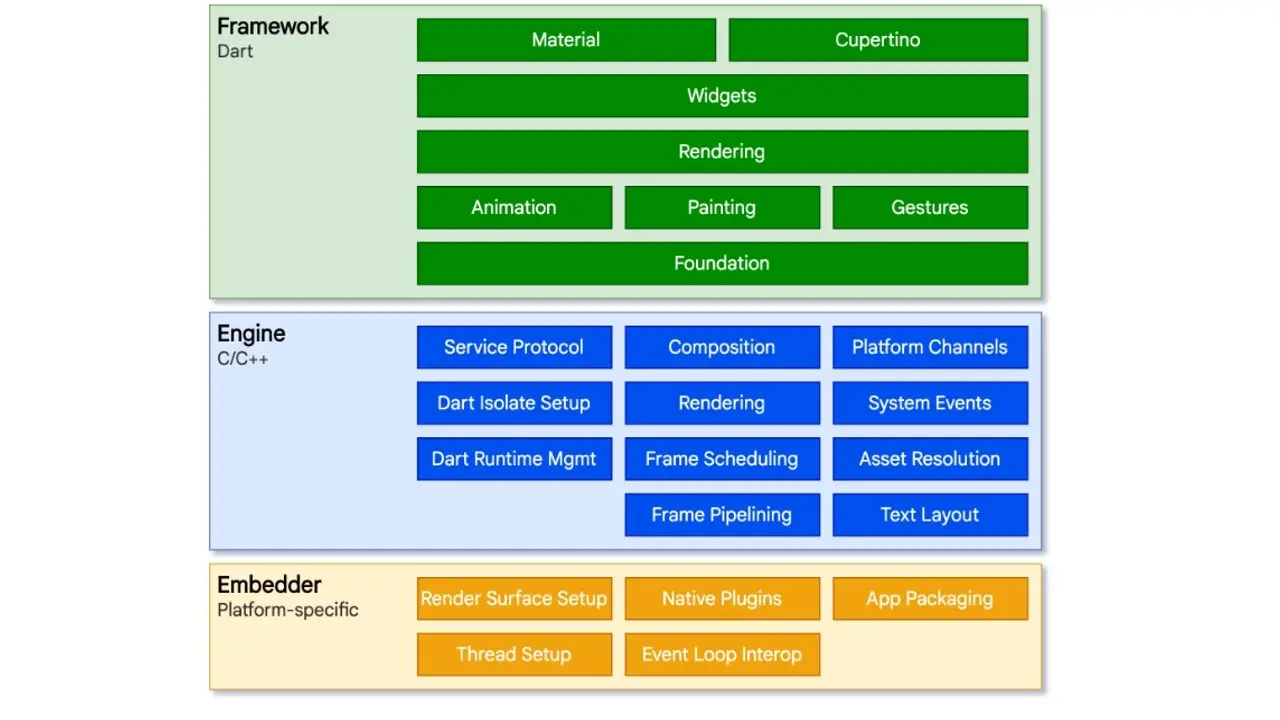
src: https://docs.flutter.dev/resources/architectural-overview
Framework
Flutter provides a reactive framework written in Dart language. The framework platform, layouts, and core libraries comprise different layers.
Foundational Layer: The foundational layer comprises basic classes and building block services including; animation, painting, and gestures.
Rendering Layer: The rendering layer manages how the UI elements display on the screen. This layer allows developers to create a tree of objects that can be rendered, and manipulated dynamically, while the tree updates the layout to reflect changes automatically.
Widgets Layer: The widgets are visual elements like buttons, text fields, and layout containers that allow users to create UI designs easily. Material (Android) and Cupertino (IOS) are part of widgets. These widgets allow developers to create UI using material design or IOS design. In other words, if you want your application to look like a typical IOS app, use the Cupertino widget.
Engine
The engine is written in C++ and manages all required to build a Flutter application. The Flutter engine provides a low-level implementation of Flutter core API Including; text layout, network request, accessibility support, plugins, etc.
Embedder
Flutter embedder manages heavy tasks and is in charge of translating flutter code to platform-specific code.
Flutter is packaged similarly to other native applications (which are applications built for specific operating systems) when we look at how the operating system runs in the background.
There’s a platform-specific embedder - an entry point that works alongside the operating system to provide render surface setup, native plugins, event loop interop, app packaging, and thread setup,
The embedder is written in language appropriate for the specific platform, for example, Java and C++ for Android, Objective-C / Objective-C++ for IOS and MacOS, and C++ for Windows and Linux.
The embedder also allows flutter code to be integrated into existing applications as a module (which means it can be added to an existing application for its features or functionality) or as an entire content of an application.
Setting Up Flutter (use case- VS Code)
Prerequisite: Before you start building any application with Flutter, certain criteria are involved. You must understand programming fundamentals, learn the Dart language, principles of UI design, API integration, and understand how to text and debug amongst many other concepts.
It is also good practice to read the documentation to get more information about Flutter as much as possible.
Let’s get started!
Typically, the steps to set up your environment and build an application are like so; you can also visit Flutter. dev, and follow the installation process.
- Choose your development platform e.g. Windows, IOS, Linux, or ChromeOS
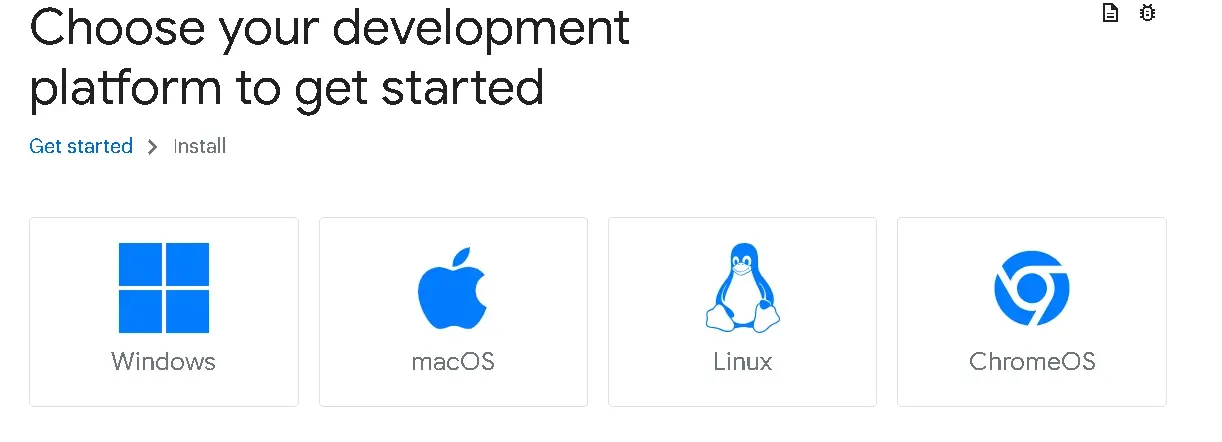
- Choose the type of app
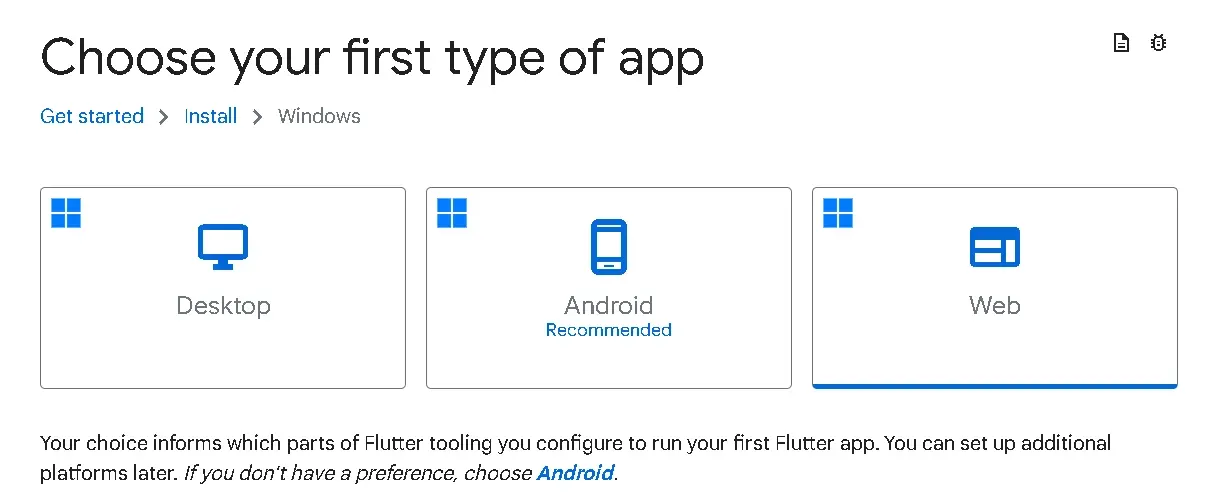
- Check the system requirements to ensure your environment meets software and hardware requirements. For instance, one of the requirements is to download and install GIT.
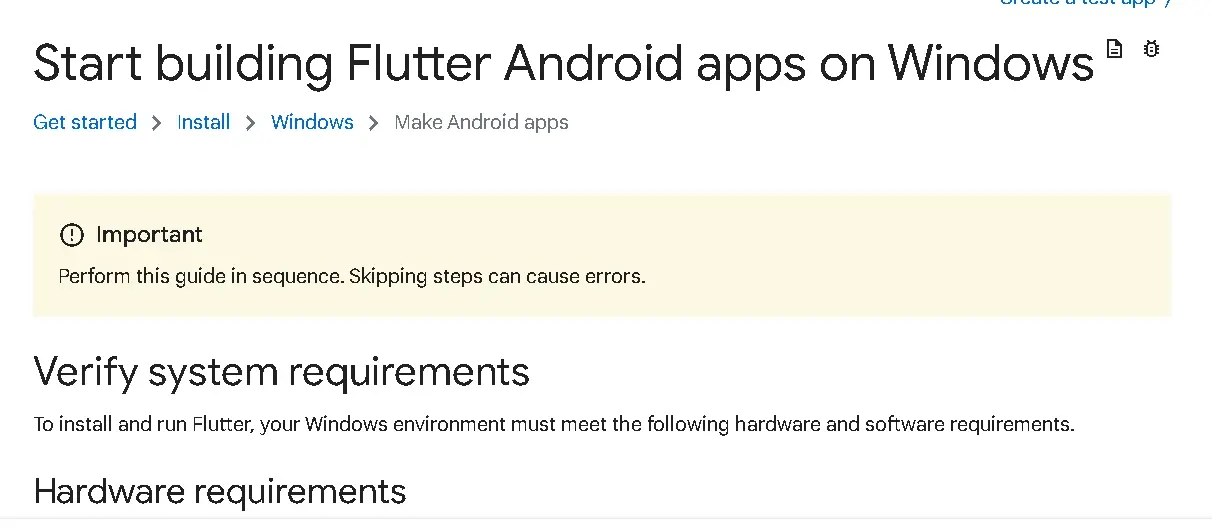
- Install Flutter SDK. You can download the SDK or prompt VScode to install Flutter. In this case, we’ll install Flutter directly in our VS code.
In VS code - go to the extensions and type flutter in the search. Once Flutter comes up, click on Install.
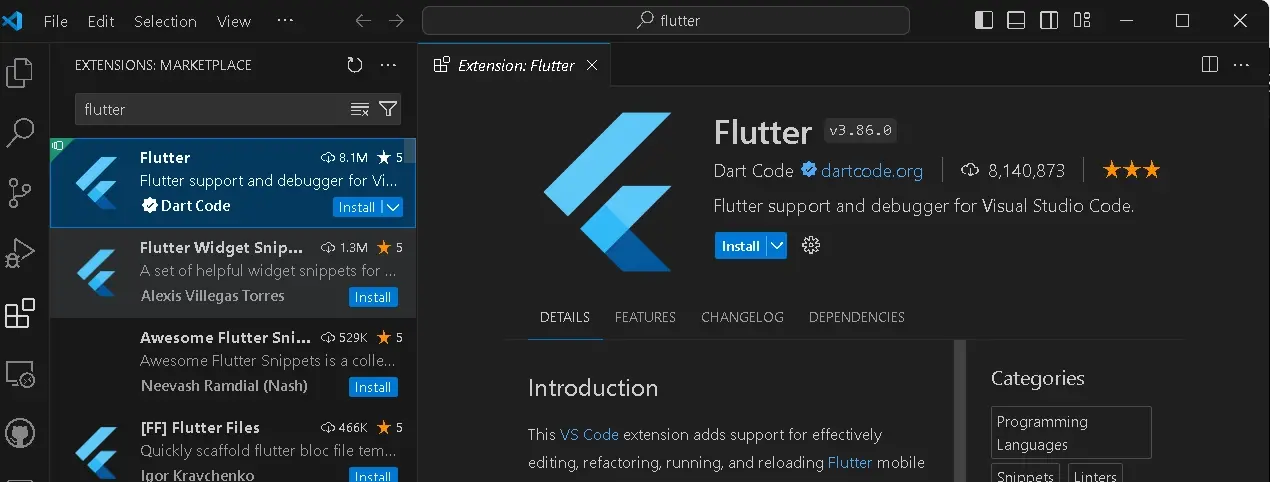
- Also, search for Dart, you’ll notice it has been installed because Flutter and Dart are related.
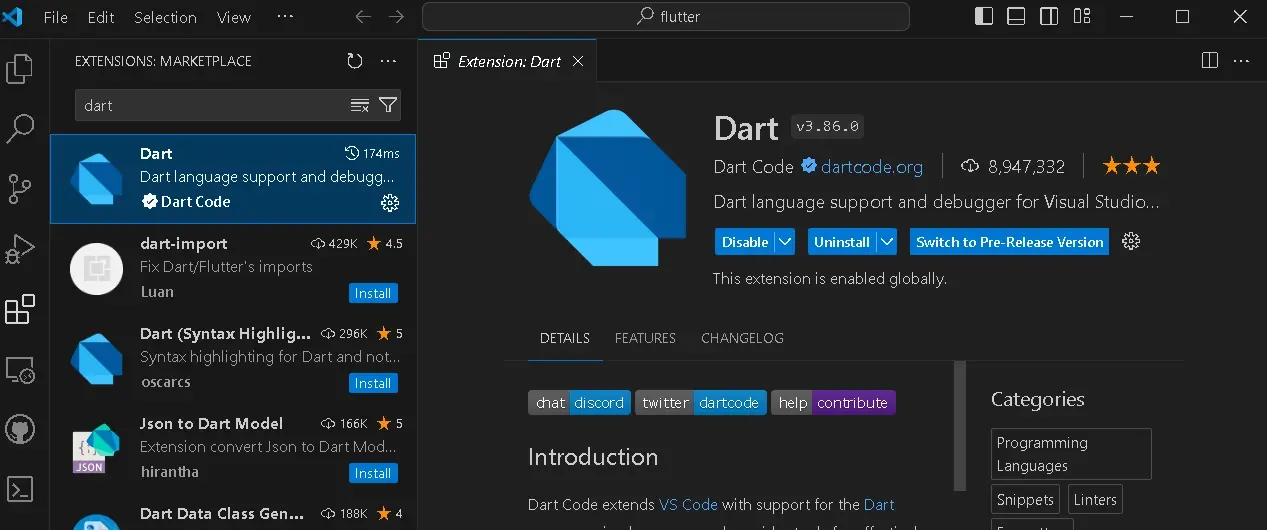
- Create a new project - Go to view or press ctr / cmd + shift + p, type in flutter, and select flutter: New Project.

- After selecting a new project you’ll get a prompt that says SDK not found, click on the download button to download Flutter SDK.
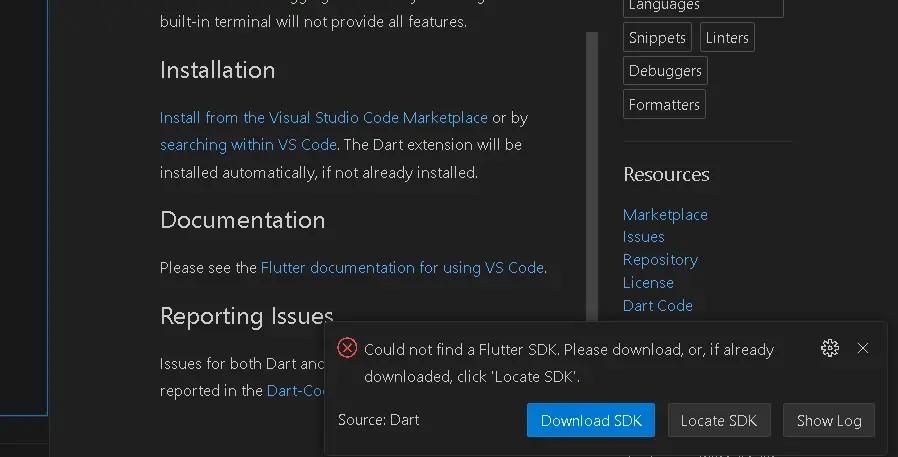
- You can download the SDK manually from the flutter.dev page if the download from VScode fails.
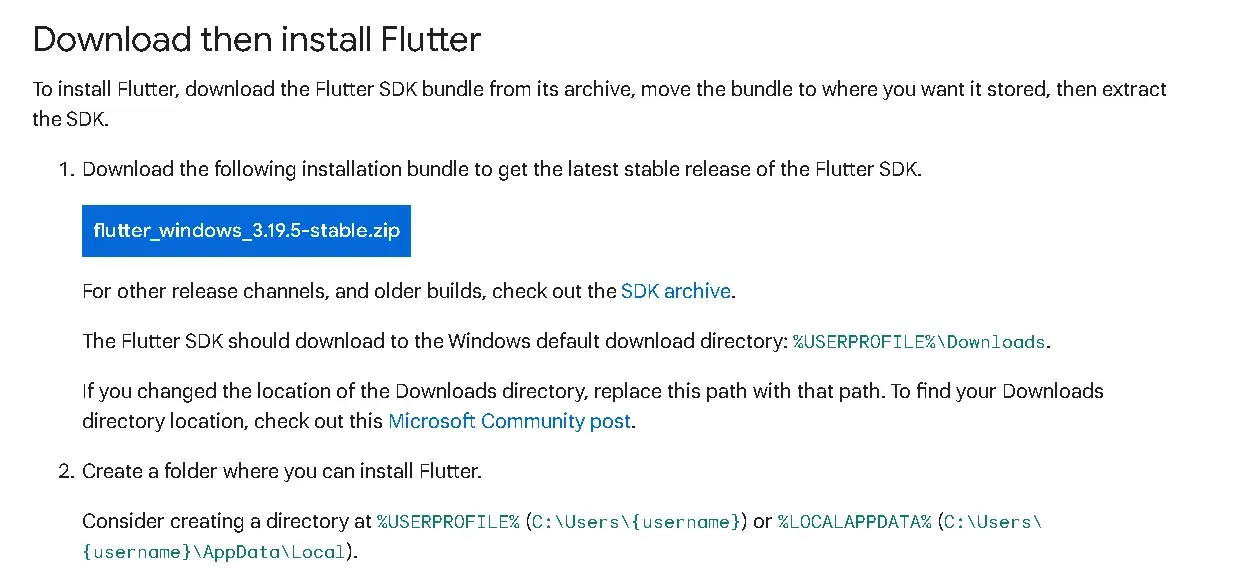
- After downloading the SDK, extract the files, using e.g. WinRAR, and copy the extracted file to your c drive.
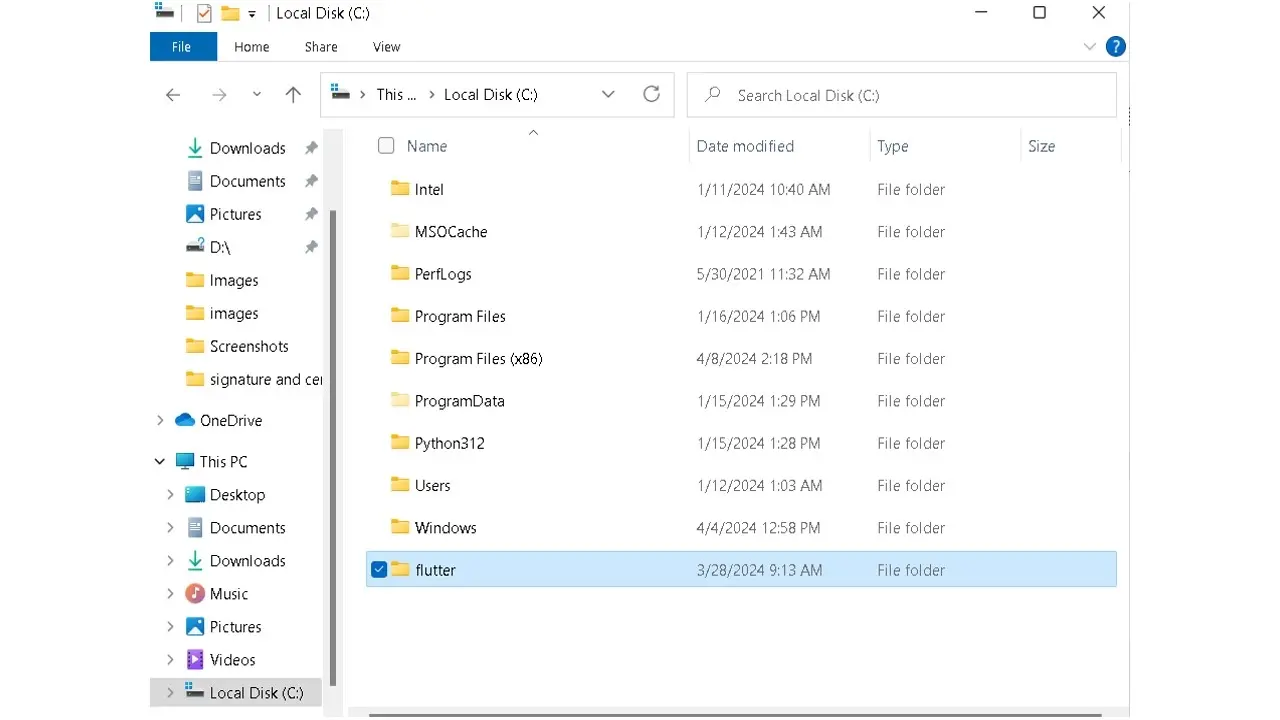
- Open the Flutter folder, search for another folder named “bin”, enter into the “bin” folder, and copy the path of the folder, so we can set the path.
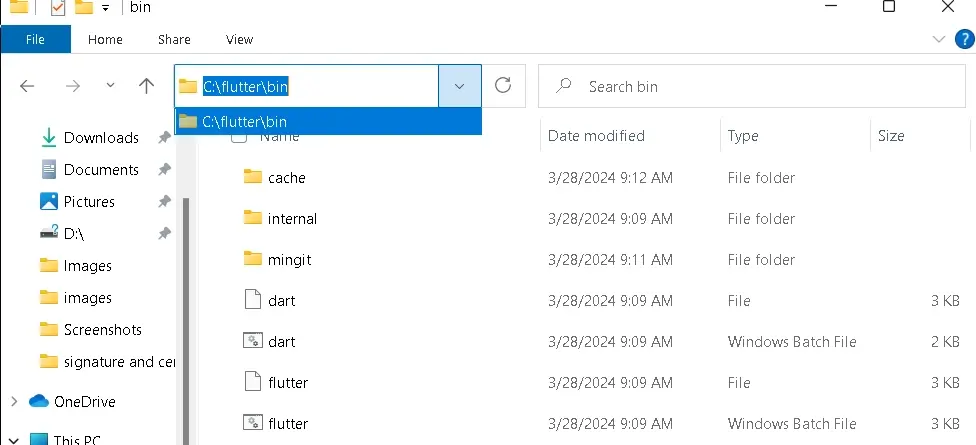
- To achieve this, go to search in Windows and type in the system environment variables, it’ll display it in the search like the image below. Click open
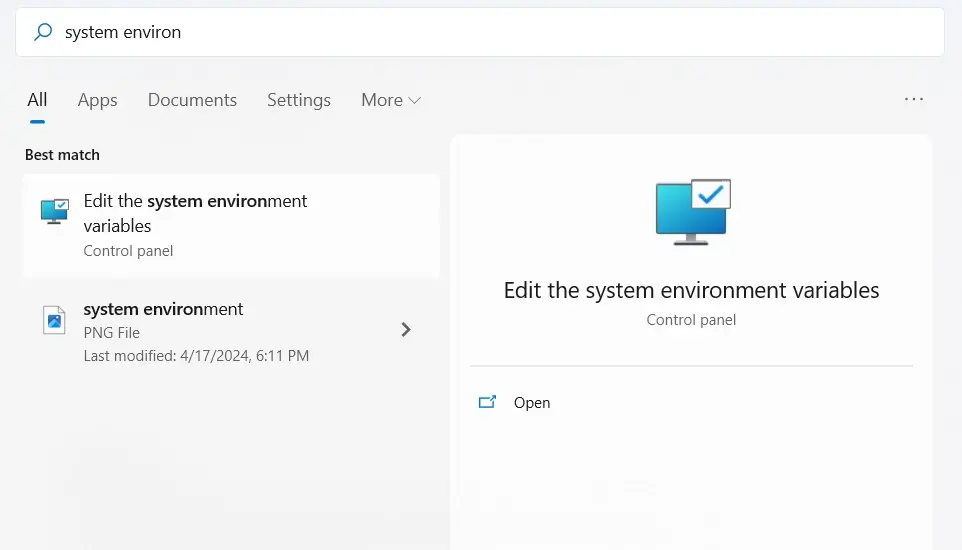
- After clicking on open, you’ll be directed to another window, select the environmental variables option at the bottom,
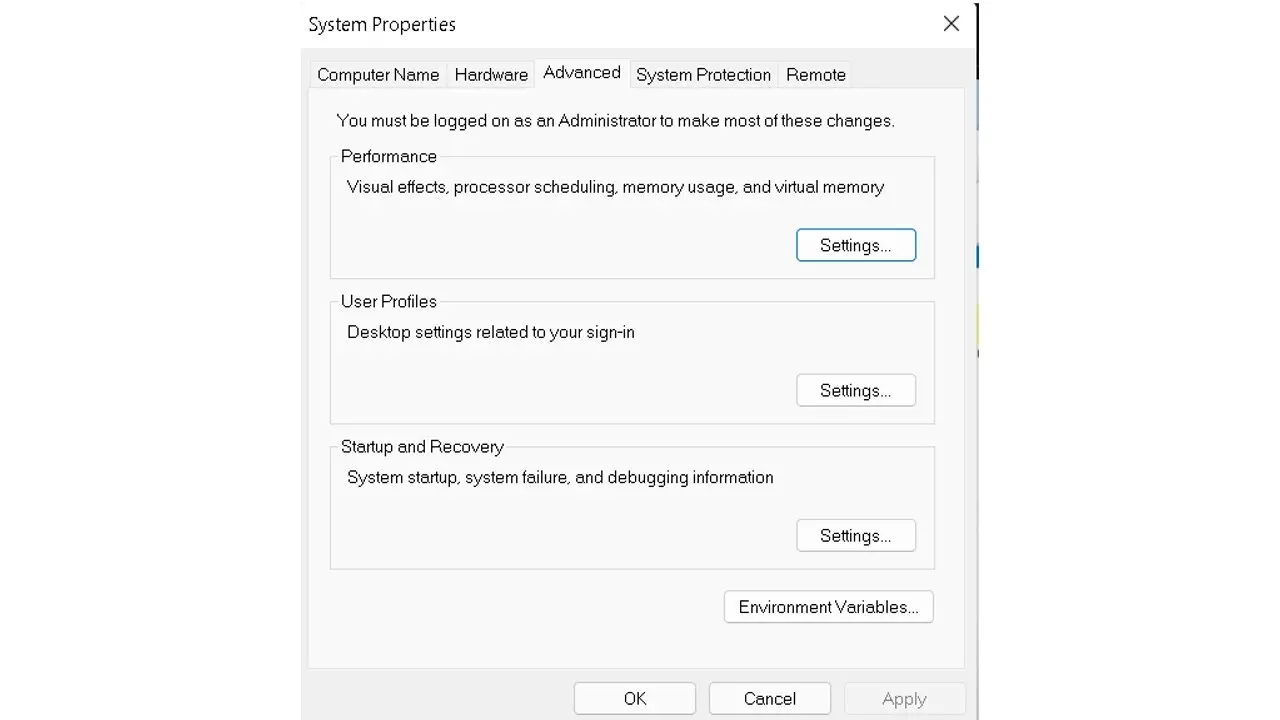
- Once the environment variables window displays, select the path option
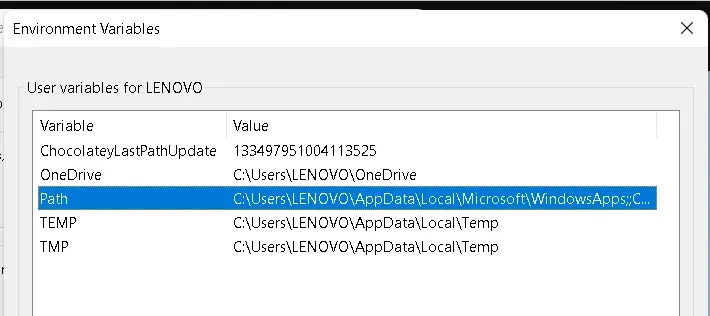
- Click on the path, it will reveal another window where we’ll add the “bin” path we copied earlier.
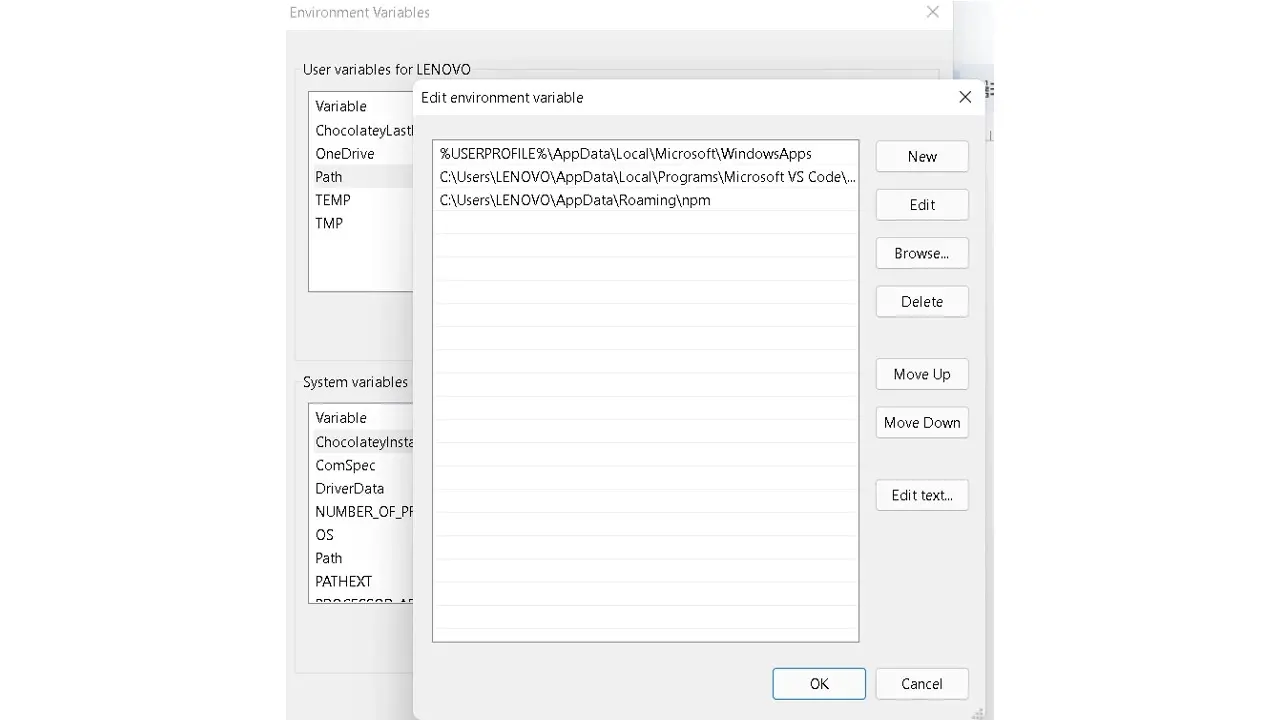
- Select the new option or double-tap the empty line to add the “bin” path and click ok.
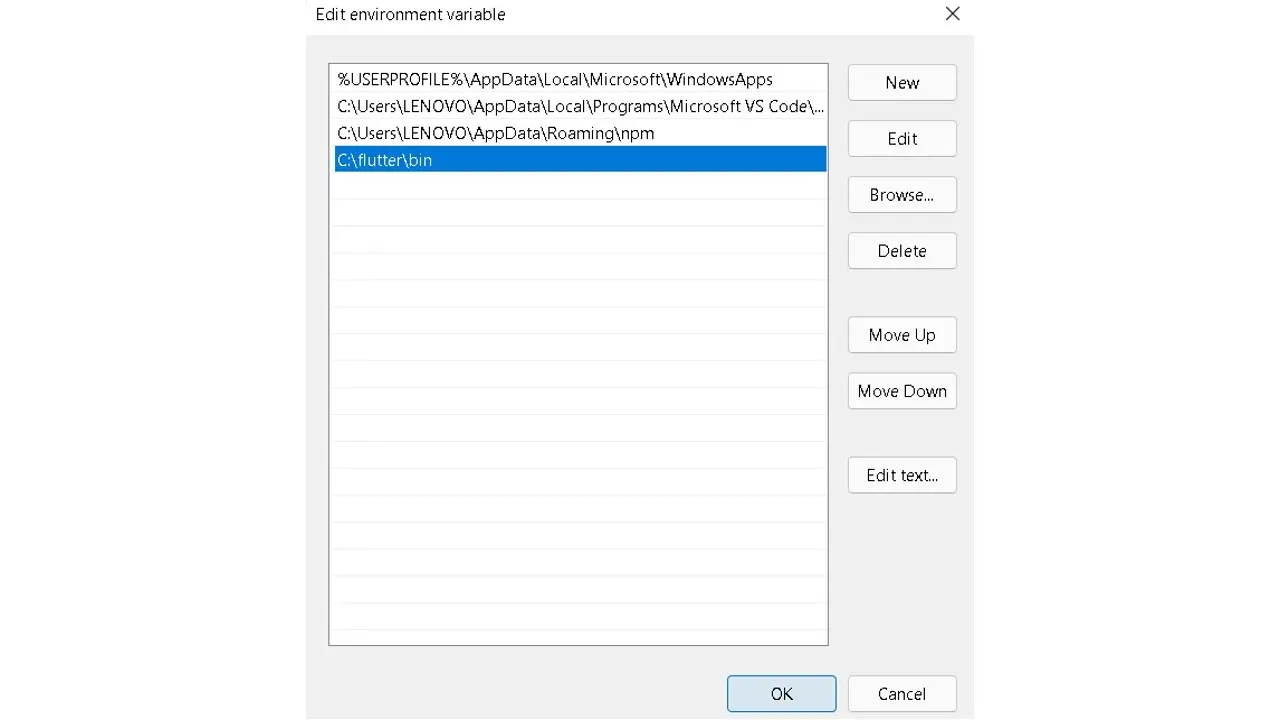
- Go to CMD(command prompt), click open, and type flutter. When you see a long list of commands like the image below it means our setup is successful.

- Let us confirm that we’ve successfully set up Flutter by typing flutter -- version like so;
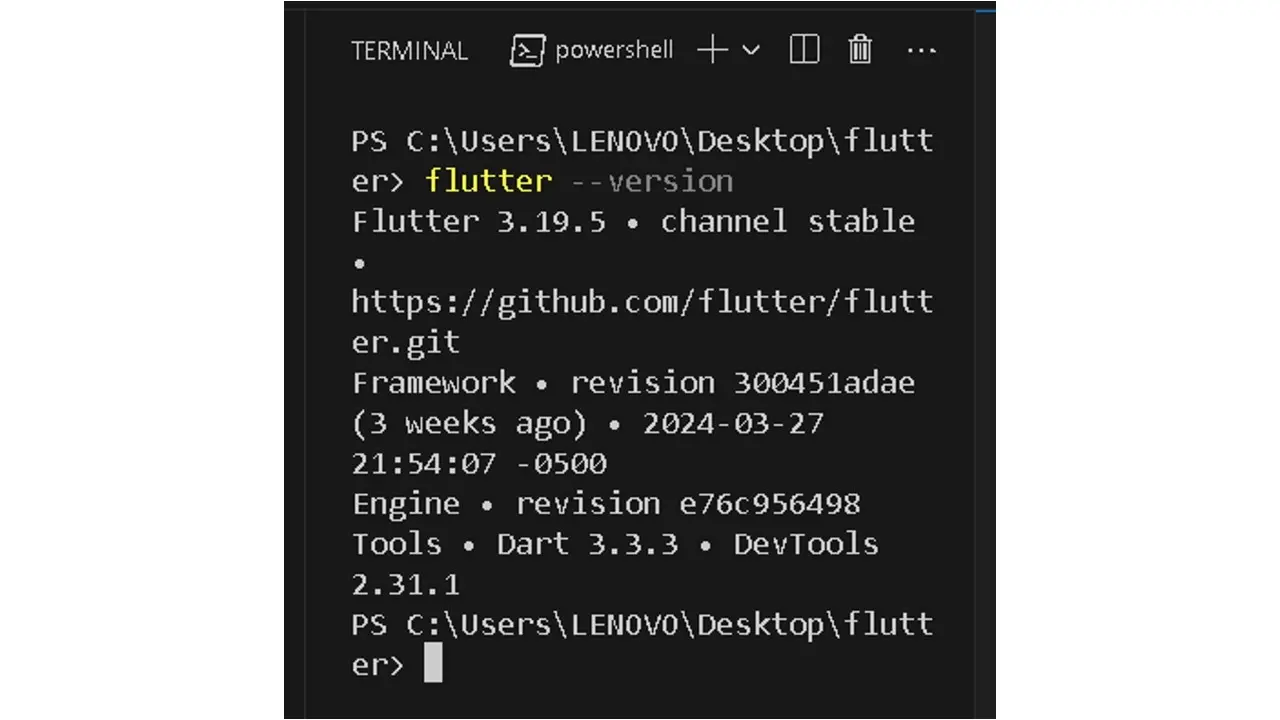
We have successfully downloaded Flutter SDK and set it up, also, we have added Flutter and Dart to VScode.
Summary
The Flutter toolkit was designed to provide developers with a means to build cross-platform applications efficiently. Flutter is one of the praised frameworks for cross-platform development which means developers can ship quality apps with ease as well as its developer experience.
Flutter ranked amongst the top 10 of last year's stack overflow for popular frameworks and libraries.
Getting started with Flutter is uncomplicated even for developers unfamiliar with Dart programming language. There are also tons of resources to help beginners, and the official documentation also provides help.
Frequently Asked Questions
What makes Astro.js different from traditional JavaScript frameworks?
Astro.js is a static site generator that prioritizes static HTML generation and minimal client-side JavaScript. Unlike traditional JavaScript frameworks, it focuses on faster performance, improved SEO, and seamless integration with multiple front-end frameworks.
Is Server-Side Rendering compatible with all web frameworks?
Not all web frameworks support Server-Side Rendering (SSR) out of the box; SSR compatibility depends on the framework.
What are some popular frameworks that support SSR?
Popular frameworks like Next.js (for React), Nuxt.js (for Vue.js), and Angular Universal (for Angular) support SSR.
Is Verpex hosting optimized for PHP frameworks like Laravel or Symfony?
Yes, our hosting is optimized for popular PHP frameworks such as Laravel and Symfony. We provide an environment that supports various frameworks, ensuring that developers can leverage these tools for efficient and streamlined PHP development.
Additionally, we offer unmatched Statamic hosting for developers. Embrace our premium Statamic hosting, optimized for efficiency. Powered by the latest technology, it's ideal for Statamic, a modern CMS that simplifies website management.

Jessica Agorye is a developer based in Lagos, Nigeria. A witty creative with a love for life, she is dedicated to sharing insights and inspiring others through her writing. With over 5 years of writing experience, she believes that content is king.
View all posts by Jessica Agorye















